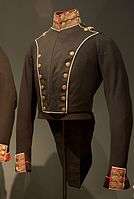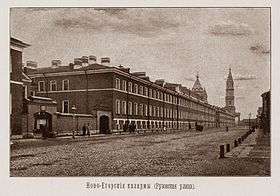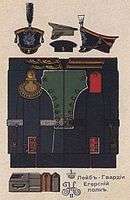Lifeguard Jaeger Regiment
- This article incorporates information from the equivalent article on the Russian Wikipedia.
| Lifeguard Jaeger Regiment — III — | |
|---|---|
|
City barracks with church in Ruzovsky street, St. Petersburg. | |
| Active | 1796-1917 |
| Country |
|
| Branch |
|
| Type | Infantry |
| Size | Regiment |
| Garrison/HQ | St. Petersburg (1914) |
| Insignia | |
| Badge of the regiment |
 |

His Majesty Lifeguard Regiment (Russian: «Лейб-гвардии Егерский Его Величества полк»), short also Lifeguard Jaeger Regiment (or: LG Jaeger Regiment), was a Jaeger regiment of the Russian Imperial Guard from 1796 to 1917.
History
The history of the LG Jaeger Regiment began in the year 1792 with the introduction of a new branch of service – the light infantry – under the leadership of Paul I of Russia. This new service branch was named Jaeger… (ru: Егер… in reference to the German noun Jäger) and in relation to the development of the European armed forces.
The first step was to identify appropriate personnel among the so-called Gattchino troops (ru: Гатчинские войска / Gatchinskie voyska) in Gatchina and Pavlovsk, and to concentrate this staff in separate Jaeger companies under the command of Major Anton Rachinski. End of 1793 there was the first restructuring, followed by the new formation in 1794. The innovative uniform of the jaeger, from green camisol, was different to uniforms used before.
By highest of all order from November 20, 1796, all units of the Gattchino troops received the status "Old guard" (ru: старая гвардия). The hitherto separate Jaeger companies were further concentrated to a jaeger battalion, strengthened by a third Jaeger company. The already existing guard regiments, the Semjonov LG Regiment and the Ismailov LG Regiment, as well as the new LG Jaeger Battalion were put under a common command. Since that point of time, November 20, 1796 was dedicated as the official day of foundation. Anton Rachinski, in the meantime promoted to podpolkovnik, became the first commanding officer of the LG Jaeger Battalion. In 1800, prince Bagration, Pyotr Ivanovich, replaced him. In order to strengthen the battalion, a third Jaeger company was added. During the battle of Austerlitz, the young Jaeger Corps received their baptism of fire and approved extraordinary combat strength.
On May 22, 1806 the personnel strength of the battalion was doubled and renamed as LG Jaeger Regiment. It was linked up to the connection of a third battalion, in order to provide a further strengthening. In 1809 Polkovnik Karl von Bistram became the new commander. Involving heavy losses during the Russo-Turkish War (1877–1878) in the battles against the Turkish Army, close to Varna, on September 10, 1828, the second battalion had to be re-established. In this connection sub-units of the 13th and 14th Jager Regiment were reallocated.
During a holy memorial service on the battle area to Kulm in the year 1835, Nicholas I of Russia in person was evaluating the extraordinary merits of the LG Jager Regiment. In this connection the day of the Saint and martyr Miron, August 17, was selected to holyday or "great day of the regiment". From this point in time Miron became the patron saint of the regiment, and in 1854 the regiment´s church received his name. In 1855 the regiment was renamed to Lifeguard Gatchinski Regiement. However, this decision was cancelled on the occasion of the great day of the regiment in 1870.
Regiment barracks
With the drawing up, the LG Jaeger Regiment was situated in the Semyeonov barracks in the street Svenigorodskaya ulitsa (later: Old Jaeger-street; Starojaegerskaya ulitsa). Afterwards it was relocated to the especially new built New Jaeger Barracks in the street Rusovskaya ulitsa, № 14, № 16 und № 18.
The winter barracks of the regiment, the so-called "Petersburg quarters", were located closely to the Semyenov place.
Regiment church
The Guard Jaeger received, as it was common tradition in Russia, an education in the spirit of submissive nature. Therefore, liberal ideas were almost unknown in the officer corps. The prosperity of the regiment was subject to individual decisions of the sovereign power. So was the decision, to build a regiment church, a mark of favour of the royal family. The church was consecrated to "Saint and martyr Myron". Emperor Nicholas I of Russia financed the building from the Privy Purse. The Church of the LG Jaeger Regiment to the Saint Myron was located close to the riverside of the Obvodnyi canal, near the estuary to the Vvedenskiy canal. It was established from 1849 to 1854 in memory to the victory of the coalition forces of Russia and Prussia in the Battle of Kulm against Napoleon, August 17, 1813, and the day of Saint Miron. The church was built to plans of the architect Konstantin Thon. Distinguished staff of the regiment were laid to rest there.
The church also served as a war memorial to the fallen in World War I. However, in connection to the suppression of the Russian Orthodox Church the Church of the LG Jaeger Regiment to the Saint Myron was used as a storehouse up to 1930. In 1934 the already-damaged building was blown up.[1] Today, on the untilled particular area is only a carwash. In line with plans of city fathers and the church the historical regiment church is to be reconstructed in accordance with the original documents.
Clours
-

Ordinance Flag, issue 1813
-

Colour (to the 100 anniversary 1796-1896)
Rank insignia
Officers
 |
 |
 |
 |
 |
 |
 |
 |
 | |||
|---|---|---|---|---|---|---|---|---|---|---|---|
| Shoulder board | |||||||||||
| Rank designation |
Adjutant general | Major general | Polkovnik | Podpolkovnik | Kapitan | Stabskapitän | Poruchik | Junior poruchik | Praporshchik | ||
| General officers | Staff officers | Senior officers | |||||||||
Non-commissioned officer and enlisted men
 |
 |
 |
 |
 |
 |
 | ||
|---|---|---|---|---|---|---|---|---|
| Shoulder board | ||||||||
| Rank designation |
Praporshchik deputy, (previous assigned to Feldwebel) | Feldwebel | Junior feldwebel | Sergeant | ... with volunteer privileges |
Gefreiter | Private | |
| Group | Non-commissioned officers | Enlisted men | ||||||
Chiefs of the regiment
The table below contains the regiment´s chiefs or honour commanders from 1796 to 1917.
| Period | Name | Rank | Note |
|---|---|---|---|
| November 9, 1796 — June 9, 1800 | Rachinsky, Anton Michailovich | Podpolkovnik | 1800 Generalleutnant |
| June 9, 1800 — September 12, 1812 | Pyotr Bagration | Major general | 1809 General of the infantry |
| November 27, 1813 — June 15, 1831 | Konstantin Pavlovich Romanov | Tsarevich (heir apparent) and Grand Duke of Russia | |
| June 25, 1831 — February 18, 1855 | Nicholas I | Emperor of Russia | |
| February 19, 1855 — March 1, 1881 | Alexander II | Emperor of Russia | |
| March 2, 1881 — October 21, 1894 | Alexander III | Emperor of Russia | 2nd chief from October 28, 1866 |
| November 2, 1894 — March 4, 1917 | Nicholas II | Emperor of Russia |
-

А.М. Rachinski — 1st regiment´s chief
-

Tailcoat uniform of Nicholas I — honour commander
-

Officer´s kitel (tunic) about 1910
Battles
The LG Jaeger Regiment participated in the Napoleonic Wars, Russo-Turkish War of 1828–1829, the campaign to put down the November Uprising in Poland in 1830-31, Russo-Turkish War of 1877–1878 and First World War. The table below contains extracts from the combat calendar of the regiment.
1805 — 1878
- 1805-07 — Napoleonic Wars:
- 20.11.1805 battle of Austerlitz
- 24.5.1807 — battle of Lomitten
- 2.6.1807 — battel of Friedland
- 1808-09 — Finnish War:
- 10,15, 18.6.1808 — in fights of the town Kuopio
- 15.10.1808 — fight of lake Porovesy (close to vil. Idensalmi)
- 29-30.10.1808 — fight of vil. Idensalmi
- 20.11.1808 — occupation of Uleaborg
- 26.2.-7.3.1809 — expedition of Alandskie (one battalion) in the corps of Pyotr Bagration
- 1812 — French invasion of Russia
- 5.8.1812 — Battle of Smolensk
- 24-26 August 1812 — Battle of Borodino
- 5.11.1812 — battle in the area of Krasny-Dobroe
- 1813-14 — battles abroad:
- 8-9 May 1813 — battle of Bautzen
- 17.8.1813 — battle of Kulm
- 4, 6.10.1813 — Battle of Leipzig
- 19.3.1814 — occupation of Paris
- 1828—1829 — Russo-Turkish War
1914 — 1917 First World War:
- 20.8.1914 — encounter battle of Vladislavo
- 24.8.1814 — fight of the vils. Kshchonov, Gelchv
- 25-26 August 1914 — fight of the vils. Zarshov, Urshulin
- 2.9.1914 — fight of the Krcheshov BP
- 10-13 October 1914 — fights in the region Ivanogorod (in reserv)
- 19-21 October 1914 — struggles in the region of the vil. Lagov
- 22.10.1914 — fight of the vils. Khmelnik, Lagevniki
- 23.10.1914 — occupation town Pinchov, reg. Nida
- 3-7 November 1914 — fights in the region: position Skala - sel. Sulashov
- 11.11.1914 — fight of the vils. Poremba, Dzerzhna
- 12.1914-01.1915 — regiment in reserv
- 5.2.1915 — fight of the vils. Gorki, Kobylin
- 6, 19.2.1915 — fight of the vil. Vysoke-Malo, hill «85,0»
- 16-18 July 1915 — fight of the vil. Krupe
- 19-20 July 1915 — fight of the vil. Stavok
- 30.7.1915 — fight of the vil. Pertilov
- 1.8.1915 — fight of the vil. Goleshov
- 29.8.1915 — fight of the vils. Ulichely, Antoneytsy
- 30.8.-3.9.1915 — fights in the region: lake Korve — vil. Kramnishki
- 6.9.1915 — fights in the region: m. Soly — vil. Kzenzuvskie Zaezertsy
- 8.9.1915 — fights on lake Rishoe, vils. Antonishki, Andresheevtsy
- 9, 13.9.1915 — fight of the vil. Menki
- 16, 17, 22.9.1915 — defence battles in the area of Smorgon
- 10.1915-6.1916 — regiment in reserv
- 15-16 July 1916 — assault in the region: vil. Reymesto on the road Stokhot
- 24.7.-24.8.1916 — BP in the region Kukharsky forrest
- 30.8.-15.9.1916 — BP in the region Svinyukhinsky forrest
- 9.1916-5.1917 — position fights in the region: Svinyukhinsky forrest, Kvadrat forrest, and forrest Sapog on the Stokhod road
- 23.6.1917 — assault of vil. Tavotloki
- 6-15 July 1917 — defence towns Tarinopol, Zbarazh
Famous people
The table below contains a selection famous people, who served in the 'LG Jaeger Regiment.
- Aleksei Antonov — General of the Army, member of the supreme command, Chief of General Staff 1945-46, 1st CS of the coalition armed forces of the Warsaw Pact member states.
- Aleksey Arbuzov — General of the Infantry, participant in the Napoleonic Wars
- Ivan Armsgeymer — bandmaster, composer
- Aleksey Baiov — lieutenant general, Russian military historian
- Yevgeny Baratynsky — poet
- Nikolay Baumgarten — general, participant Russo-Turkish War (1828–29), military educationalist
- Yakov Bologovsky
- Karl Vrangel — general of the infantry
- Yevgeny Graf — lieutenant general
- Boris Regua — major general
- Aleksandr Gueldenschtubbe — general of the infantry
- Michael Grabbe — general
- Onufry Kvitsinsky — general
- Aleksey Kologrivov — major general
- Kibrian Kondratovich — general of the infantry
- Nikolay Krivtsov — captain of the LG Jaerger Regiment
- Fyodor Lindfors — major general
- Michail Matsnev — major general
- Pyotp Nesterov — lieutenant general
- Vladimir Notbek — general of the infantry
- Vasily Ovander — lieutenant general, participant in the Napoleonic Wars
- Gavriil Okunev — major general
- Ivan Pavlov — general of the infantry
- Stepan Polyeshov — lieutenant general
- Aleksandr Ridiger — major general
- Boris Richter — lieutenant general
- Fyodor Sazonov — major general
- Pyetr Stepanov — general of the infantry
- Ilya Tutaev —
- Ivan Cherkmaryov — lieutenant general
- Alfons Shanyavsky — goldmine owner
- Ivan Shachovskoy — general of the infantry
- Vyacheslav Shteyngel — general of the infantry
- Dmitry Shcherbachev — general of the infantry
Commanders
The table below contains the commanding officers of the regiment.
- 7 March 1805 — 19 November 1809 — polkovnik Guillaume Emmanuel Guignard, vicomte de Saint-Priest
- 19 December 1809 — 29 May 1821 — polkovnik (from Nov. 21, 1812 major general) Karl von Bistram
- 10 August 1821 — 14 March 1825 — major general Yevgeny Golovin
- 14 March 1825 — 10 September 1828 — polkovnik (later on major general) Pavel Gartong[2]
- 13 September 1831 — 3 May 1833 — major general Pavel Shtegelman
- 02.04.1833 — 22.09.1841 — major general Aleksandr von Moller
- 22.09.1841 — 20.03.1850 — major general Vcevolod Solovyov
- 20.03.1850 — 02.04.1855 — major general Osip Musnitsky
- 02.04.1855 — 29.02.1856 — major general Yakov Voropay
- 29.02.1856 — 23.04.1861 — major general Wilhelm Hansen
- 23.04.1861 — 25.05.1863 — major general Baron Erst von Willebrand
- 25.05.1863 — 06.12.1864 — major general
- 06.12.1864 — 08.02.1868 — major general Michael Koropotkin
- 13.02.1868 — 17.04.1876 — polkovnik Aleksandr Ellis
- 17.04.1876 — 17.04.1880 — polkovnik (from Oct. 12, 1877 major general) Aleksey Chelishchev
- 17.08.1880 — 04.05.1887 — major general Aleksandr Frezer
- 18.05.1887 — 17.02.1891 — major general Khozrev Dolukhanov
- 17.02.1891 — 24.11.1894 — major general Ivan Maltsov
- 24.11.1894 — 20.11.1895 — major general Pavel Shubalov
- 28.11.1895 — 25.04.1900 — major general Andrey Cherkmaryov
- 11.07.1900 — 03.06.1903 — major general Konstantin Rozen
- 03.06.1903 — 18.02.1906 — major general Leonid-Otto Sirelius
- 18.02.1906 — 10.07.1908 — major general Andrei Zayonchkovski
- 10.07.1908 — 14.12.1913 — major general Vladimir Yablochin
- 14.12.1913 — 02.02.1916 — major general Aleksandr Bukovsky
- 02.02.1916 — 10.04.1917 — polkovnik (from Apr. 5, 1816 major general) Boris Grekov
- 05.04.1917 — 08.09.1917 — polkovnik Oleksander Hrekov
- 08.09.1917 — 12.1917 — polkovnik Fyodor Shtakelberg
References
- ↑ Церковь святого Мирония на сайте Исторія и Архитектура Санктъ-Петербурга
- ↑ Убит 10 сентября 1828 года в бою при Гаджи-Гассан-Лар.
External links
- Saint Petersburg encyclopedia
- Staff-officers and Junior-officers of the 'LG Jaegerregiment
- Commanders and Chiefs of the LG Jaegerregiment 1806—1834
- Military march of the LG Jaeger Regiment

